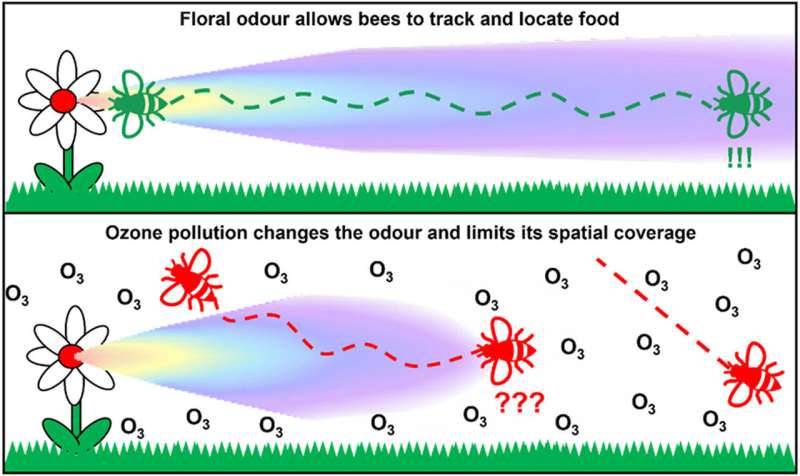This article has been reviewed according to Science X's editorial process and policies. Editors have highlighted the following attributes while ensuring the content's credibility:
fact-checked
peer-reviewed publication
trusted source
proofread
Air pollution prevents pollinators from finding flowers, study shows

Air pollution dramatically reduces pollination because it degrades the scent of flowers, affecting bees' ability to find them, a study has found.
A research team comprising the UK Center for Ecology & Hydrology (UKCEH) and the Universities of Reading, Surrey, Birmingham and Southern Queensland, found that ozone substantially changes the size and scent of floral odor plumes. It reduced honeybees' ability to recognize odors by up to 90% from just a few meters away.
Ground-level ozone, which aggravates respiratory conditions, typically forms when nitrogen oxide emissions from vehicles and industrial processes react with volatile organic compounds (VOCs) emitted from vegetation in the presence of sunlight.
Dr. Ben Langford, an atmospheric scientist at UKCEH led the study, which has been published in the journal Environmental Pollution. He says the new research suggests that ozone is likely having a negative impact on wildflower abundance and crop yields. Several international studies have already established that ozone has a negative impact on food production because it damages plant growth.
"Some 75% of our food crops and nearly 90% of wild flowering plants depend, to some extent, upon animal pollination, particularly by insects. Therefore, understanding what adversely affects pollination, and how, is essential to helping us preserve the critical services that we reply upon for production of food, textiles, biofuels and medicines, for example," says Dr. Langford.
Dr. James Ryalls, a University of Reading co-author of the research paper, said, "The study provides clear mechanistic evidence of how ozone pollution, concentrations of which are typically higher in rural areas, can reduce pollinator visitation to flowers."
The researchers used a wind tunnel to monitor how the size and shape of odor plumes changed in the presence of ozone. As well as decreasing the size of the odor plume the scientists found that the scent of the plume changed as certain compounds reacted away faster than others.
Honeybees, which were trained to recognize the same odor blend, were then exposed to the new, ozone-modified odors. Pollinating insects use floral odors to find flowers and learn to associate their unique blend of chemical compounds with the amount of nectar it provides, allowing them to locate the same species in the future.
The research showed that toward the center of plumes, 52% of honeybees recognized an odor at six meters, decreasing to 38% at 12m. At the edge of plumes, which degraded more quickly, 32% of honeybees recognized a flower from 6m away and just a tenth of the insects from 12m away.
The researchers say their findings indicate ozone could also affect insects' other odor-controlled behavior such as their ability to attract and find a mate. Last year, the same research team published the first study to find common air pollutants, including ozone and diesel exhaust fumes, had a negative impact on pollination in the natural environment.
More information: Ben Langford et al, Mapping the effects of ozone pollution and mixing on floral odour plumes and their impact on plant-pollinator interactions, Environmental Pollution (2023). DOI: 10.1016/j.envpol.2023.122336
Journal information: Environmental Pollution
Provided by University of Reading




















